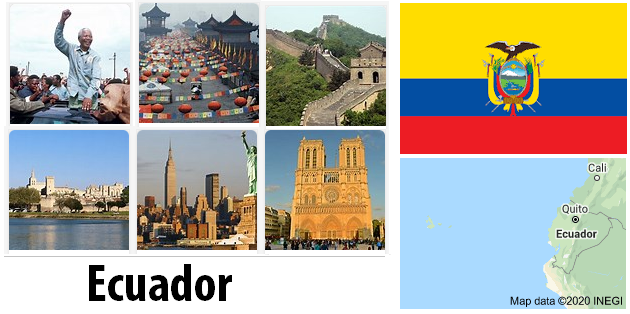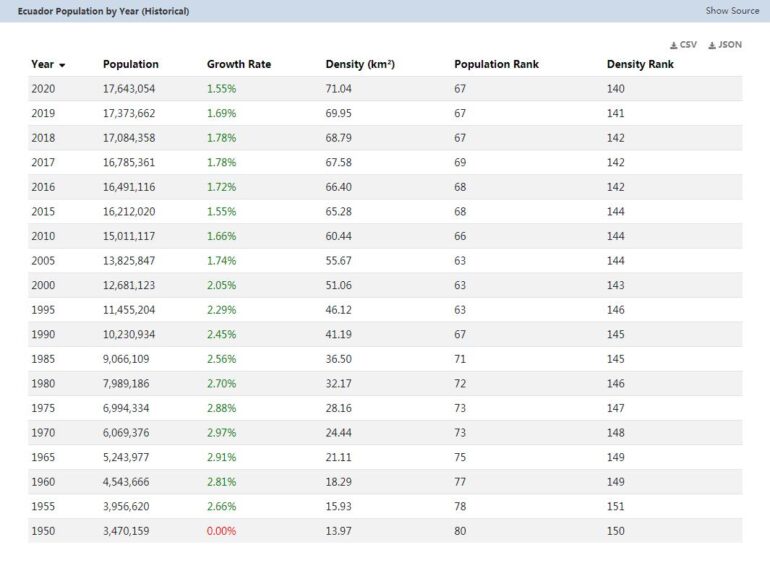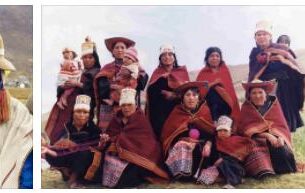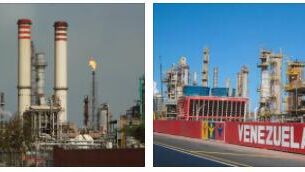Ecuador, so called because it is crossed by the Equator, is actually a country with a mild, almost spring temperature.
Its first inhabitants were very quiet people, who dealt with agriculture and breeding.
According to legend, these first peoples were the Quitu, who, around the year 950 AD, were submerged by the Caras or Scyri, warlike tribes that came down from the Andes and occupied the territory for about three centuries. They founded the city of Cara and discovered the Esmeraldas river.
Around 1250 the formidable Incas, starting from Cuzco, began the first raids in Ecuador which soon became real wars of conquest, until between 1478 and 1488 the whole territory was annexed to the kingdom of Cuzco.
The entire conquest had been completed by Huayna Capac, who at his death divided the kingdom into two parts: the northern one was assigned to his son Atahualpa and the southern one to his son Huascar. After a short time the two brothers declared war; the winner was Atahualpa, king of Quito. And after only 45 years of Incas domination the Spaniards arrived.
The first explorer who entered Ecuador in 1526 was Bartolome Ruiz. But in 1531 Francesco Pizarro arrived who subdued the whole region, took Atahualpa prisoner and executed him in 1533. Without warning, his lieutenant Sebastian de Belalcazar headed north and defeated the chief of Quito in combat, which was set on fire by its inhabitants. Then, on August 28, 1534 he founded the city of S.Francisco de Quito.
In 1538 Lorenzo de Aldana arrived in Quito who took over the government, in which he had many successors, until in August 1563 a “Real Audiencia” was established, that is, a special court of Spanish judges with the widest powers, including administrative and Ecuador was elected to “Presidencia”, and was governed as a common colony because it proved to be poorly supplied with gold so the Spaniards did not consider it worthy of too much effort.
In reality power was exercised by the famous “Council of the Indies”, which was a supreme assembly of Spanish nobles, appointed by the king to administer and direct all affairs of the New World; the governors of the new territories were appointed on a proposal from the Council.
Until 1740 the Ecuadorian region was considered by the Spaniards as a dependence of the Vice-realm of Peru; then of the Vice-realm of the New Grenade and remained so until 1809. The Spanish dominion, even if hard, managed to civilize those populations and to introduce Catholicism. See Countryaah for population and country facts about Ecuador.
Many governors succeeded each other at a fast pace. In 1753, during the assignment of Juan Pio de Montufar, Marquis of Selva Alegre, terrible earthquakes occurred which destroyed Quito and Lacatunga. When the Marquis died in 1761, Audiencia took over the government “ad interim”.
In 1767 Josè Diguja took office and immediately took on the task of expelling the Jesuits.
He was succeeded by 5 other presidents and in 1806 Manuel Urriez, count Ruiz de Castilla, came to power.
News of the French Revolution and Napoleon’s invasion of Spain had arrived in America. So the Ecuadorian patriots, who had been agitating for some time, thought it was time to free themselves from Spanish rule; then they rose up on July 28, 1809 and on August 10 they took Urriez prisoner.
Evidently the time had not yet come because Spain, after having committed Napoleon to the bottom, managed to bend the insurgents and Urriez returned to power.
In November 1810 the Spanish government appointed Joaquin de Molina as president but on 11 December 1811 the Ecuadorian provisional government, from its refuge in the mountains, declared the country’s independence, even though the Spaniards were still the effective masters of the territory.
It went on like this, with a fierce guerrilla warfare ruthlessly suppressed, until 1819. In that year the great Simon Bolivar, the “Libertador” entered the scene. After crossing the Andes, he attacked the Spanish army north of Bogota from behind and defeated him.
In December 1819 an assembly gathered in a small town, Angostura, approved a “Basic Law”, which declared the Republic of Gran Colombia, consisting of three departments, with the capitals Caracas, Bogota and Quito to be constituted. Since the latter was still in the hands of the Spaniards, military operations resumed and, after severe struggles, on May 24, 1822, General Sucre, lieutenant of Bolivar, definitively defeated the Spaniards. Ecuador was free.
In 1830 Grande Colombia was dissolved, Ecuador was declared independent and General Flores was elected for the first time. These, after an intermediate presidency of Vicente Rocafuerte returned to power in 1839 but in 1845 an insurrection forced him to abandon and he left for Europe.
Ecuador, like all South American republics, had a life troubled by constant coups d’état. In fact, from 1830 to 1940 there were 33 presidents, some of whom were absolute dictators. For the years 1929-1932 the Constituent Assembly temporarily appointed Isidro Ayora and on March 25, 1929 a new Constitution was proclaimed and adopted.
In those years, however, there were numerous riots and internal struggles that troubled the country. On October 1, 1932 even Sotomayor, Minister of War, was arrested on charges of conspiracy. In 1933 Ecuador had to mobilize in view of the conflict between Peru and Colombia, but its intervention was not necessary. Instead, there was a serious general strike in August.
In early June 1938, under the presidency of A. Enriquez, a border accident occurred with Peru which, rekindling old border disputes, brought considerable tension between the two countries.
In January 1940 Carlos Arroyo del Rio was regularly elected, and with him there was a certain tranquility both within and in foreign policy.
At the outbreak of World War II, Ecuador declared itself neutral and with it the Galapagos Islands.
To gain US support in relation to the border conflict with Peru, Ecuador broke commercial treaties and diplomatic ties with Germany, Italy, Japan and all European states aggregated to the Axis. In 1942 he also broke all ties with the Vichy government.
Then the dispute with Peru was resolved and Ecuador could have a part of the disputed territory and also the authorization to sail on the Amazon River.
The Congress was not very satisfied with the agreement, reached through the mediation above all of the United States, with which then important commercial relations were concretized, in exchange also for loans and economic facilities.




